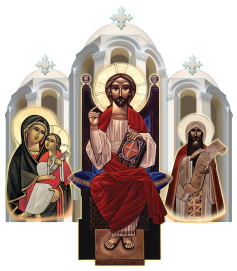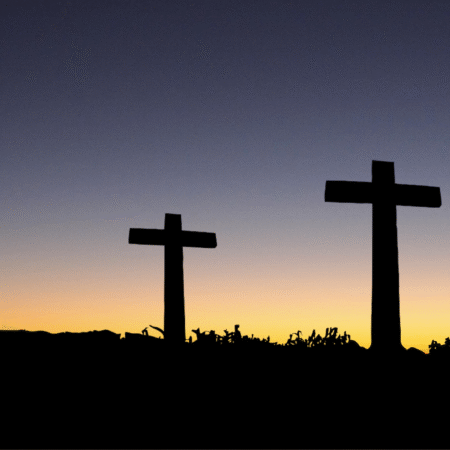The Celebration of Our Weapon
17th-19th of Tout (September 27th-29th, 2025)
The foundation of our faith as Coptic Orthodox Christians is the cross. Through His grueling suffering on the Cross, Christ granted us eternal life; opened up a path for our salvation; provided us with a weapon against any pain or struggle; redeemed our corrupt nature; and allowed us to be with Him in His heavenly kingdom. Without the Cross, our faith is null. St. Cyril speaks of the importance of the Cross, saying, “The holy wood of the Cross bears witness, seen among us to this day, and from this place now almost filling the whole world, by means of those who in faith take portions from it” (Catechetical Lectures 10.19).
The first of two Feasts of the Cross is celebrated between the 17th–19th of Tout (September 27th–29th). The September Feast of the Cross commemorates two events. The first is the appearance of the Sign of the Honorable Cross to Emperor Constantine before the Battle of Milvian Bridge. In 312 AD, the political situation was tense. Two Romans, Emperor Constantine I and King Maxentius, were in battle as both believed they were heirs to the imperial throne. Leading up to the Battle of Milvian Bridge, in a vision, Emperor Constantine saw the sign of the Cross. According to tradition, under the Cross were the words “In this sign, conquer” (Latin: In hoc signo vinces). Subsequently, he put the sign of the Cross on all banners and the armor of his soldiers. King Constantine successfully defeated Maxentius. Though Constantine was not immediately baptized, this vision became a seed planted by God, which later influenced him to issue the Edict of Milan (313 AD), ending centuries of Roman persecution against Christians. Additionally, the September Feast of the Cross commemorates the joint veneration of the Honorable Cross between the Patriarchs of Alexandria, Constantinople, Antioch, and Jerusalem that occurred in 335 AD.
The second Feast of the Cross occurs on the 10th of Paremhotep (March 19th). This feast commemorates the discovery of the Holy Cross by Queen Helen (King Constantine’s mother) in 326 AD. Queen Helen was looking for the Cross in Jerusalem and found three crosses in Golgotha. However, they were not sure which one was the Cross Christ was crucified on. According to the Synaxarium, a dying or dead man was placed on each of the three crosses; when he touched the True Cross of Christ, he was miraculously healed and restored to life. Subsequently, Queen Helen ordered the Church of the Resurrection (more widely known as the Church of the Holy Sepulchre) to be built and consecrated there (the consecration took place the day before the joint veneration of the Cross). Additionally, the March Feast of the Cross commemorates the relocation of the Cross back to Jerusalem after it was stolen by King Khosrau II of Persia. Per tradition, when Emperor Heraclius recovered it in 628 AD, he carried it barefoot into Jerusalem in humility, returning it to its place of honor.
The Sign of the Cross is powerful. While the sign of the Cross granted King Constantine victory in this political and worldly battle, how much greater is the victory it grants us in our unseen spiritual battles! As St. Paul teaches, “The message of the cross is foolishness to those who are perishing, but to us who are being saved it is the power of God” (1 Corinthians 1:18, NKJV). Through the Cross, Christ trampled down death and granted us victory over sin, the devil, and death itself.This message is iterated through the Hymns of the Church. In the Gospel Response for the Feast of the Cross, we say: “Through His Cross and His holy Resurrection He restored man once again to the Paradise of joy.” Furthermore, in the Verses of the Cymbals for the Feast of the Cross, the congregation chants in the festive tune: “The Cross is our weapon, the Cross is our hope, the Cross is our confirmation, in our troubles and sufferings.” Once again, the Church places this reminder of the power of the Cross. It is our weapon. The Cross is a tool that we can use to overcome the arrows of the evil one. And in the doxologies, the Cross is described as “the comfort of the faithful,” “the weapon of victory,” and “the sign of salvation.”
The Church Fathers echo this truth. St. Athanasius writes: “By the sign of the cross, all magic is stopped, and every charm is broken, and the devil is made powerless” (Life of Antony, ch. 30). Likewise, St. John Chrysostom declares: “The Cross is the will of the Father, the glory of the Son, and the joy of the Spirit” (Homily on the Cross and the Thief). These ancient voices confirm what the Church continues to proclaim in her worship: the Cross is our strength and our salvation.
And if the reminder from the Church hymns is not enough, let’s look at the story of St. George. The King at the time took a magician and gave St. George a cup full of poison to drink. Upon receiving this drink, St. George made a sign of the Cross over the cup. St. George drank the poison, but it did not harm him. They then gave him another cup of poison, but this time they tied his arms back. Yet, St. George made the sign of the Cross with his head, and the poison did not harm him. Here, the power of the Cross is revealed, not as a mere symbol, but as a living weapon of grace, protecting the saints even in the face of death.
The Cross is our weapon. The Cross is our hope. The Cross is our confirmation in our troubles and sufferings. For Constantine, it meant triumph in battle; for St. George, it meant protection from death; for us, it means daily victory over sin. As St. Paul says, “God forbid that I should boast except in the Cross of our Lord Jesus Christ” (Galatians 6:14, NKJV). May we continue to reflect on the power and the beauty of the Cross and be reminded of its importance in our lives.
Sources & Further Reading:
- The Feasts of the Cross | Coptic Orthodox Diocese of Los Angeles
- The Feasts of the Cross | The Church of Archangel Michael and St. Tekla
- The Battle of the Milvian Bridge | Summary, Outcome, & Significance | Britannica
- NPNF2-01. Eusebius Pamphilius: Church History, Life of Constantine, Oration in Praise of Constantine
- Synaxarium for the 17th Tout (Coptic Reader)
- Synaxarium for the 10th Paremhotep (Coptic Reader)
- Synaxarium for the 23rd Baramouda (Coptic Reader)
- St. Athanasius, Life of Antony, ch. 30 – The Cross as protection against the devil.
- St. John Chrysostom, Homily on the Cross and the Thief – The Cross as the will of the Father and glory of the Son.

